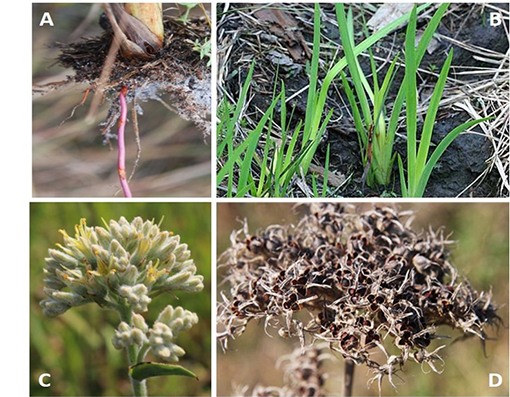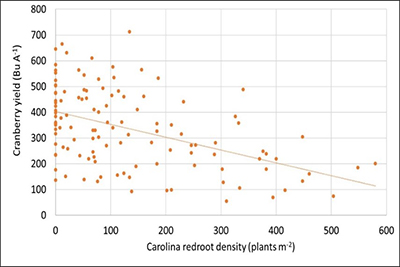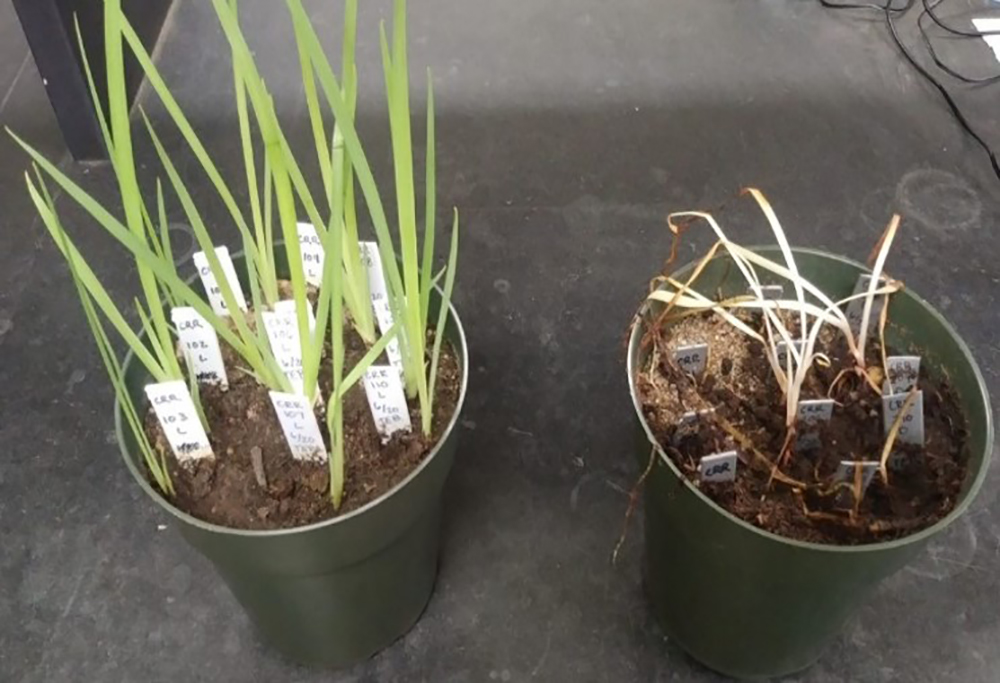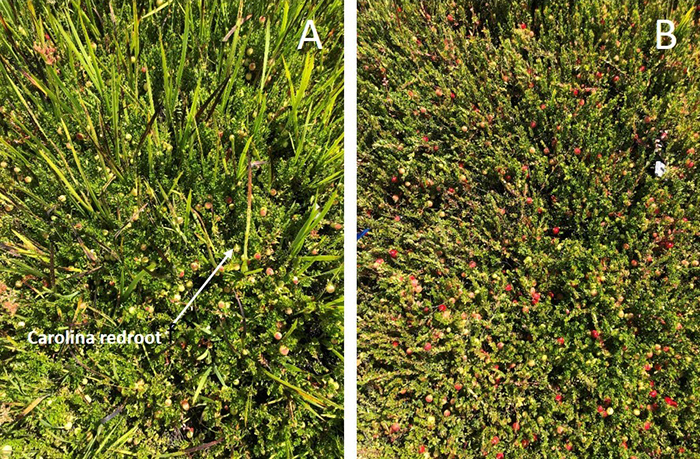Fact Sheet FS1338
Carolina redroot (Lachnanthes caroliniana) is a perennial weed found in aquatic sandy acidic areas ranging throughout the eastern coast from Louisiana to Nova Scotia. Carolina redroot is classified as a high priority weed in cranberry bogs (Sandler 2018) where full sunlight exposure, sandy acidic soils, and rapid alternation of wet and dry soil periods provide optimal conditions for this species to develop. Carolina redroot can spread by seeds, but most commonly through rhizome clonal propagation. Carolina redroot often crowds out cranberry vines and other weeds in New Jersey cranberry bogs where its development is associated with open areas where vines have been killed by fairy ring disease or other “stand opening” conditions of natural and anthropomorphic origin.

Figure 1. Carolina redroot rhizome (A), leaf blade (B), flower stalk (C), and seedhead (D). Photo Credit: Baylee Carr and Thierry Besançon.
Plant Identification
Carolina redroot is a monocot, easily identified by its namesake red roots and rhizomes (Figure 1A). The leaves are simple, alternate, and blade-like (Figure 1B). As the summer continues, Carolina redroot will grow above the cranberry canopy. Flower stalks are hairy and 1.5 to 4 inches tall with yellow flowers clustered in an inflorescence (corymb)(Figure 1C). Fruits produced by flowers are red with reddish-brown seeds inside (Figure 1D). When scouting cranberry bogs early in the season for Carolina redroot, it is important to look beneath the cranberry canopy for the fan-shaped seedlings (Figure 1B). Emergence occurs late April to early May when water has been removed from the bogs and the soil starts to warm up.
Impact on Cranberry Production

Figure 2: Impact of Carolina redroot density on cranberry fruit yield (Rutgers Weed Science).
In recent studies conducted by the weed science team at the Rutgers P.E. Marucci Center for Blueberry and Cranberry Research, Carolina redroot in cranberry bogs accounts for significant yield and economic loss. Out of 120 individual plots assessed by the Rutgers University weed science program over the last 3 years, yield loss from redroot competition averaged 26%, reaching up to 80% when weed density exceeded 400 plants per square meter (Figure 2). Overall, each Carolina redroot plant reduced cranberry yield by an average of 5 grams m-2. These losses result from direct competition for water, nutrients, and light. Fragments of the Carolina redroot inflorescence can also mix with cranberry fruit during harvest operations and hinder the industrial processing of cranberry fruits, further exacerbating the economic impact caused by this weed. The more weed debris in the bogs, the slower the cleaning process is and the more time and, thus, money spent to harvest.
Carolina redroot can also cause indirect negative effects on cranberry production. For example, the percent of fruitworm-damaged berries was shown to be strongly positively correlated with Carolina redroot weed biomass and density (Colquhoun et al. in prep.). Carolina redroot can also interfere with pesticide spray deposition, potentially reducing the effectiveness of fungicide and insecticide applications. Additionally, flowers of redroot are very attractive to native pollinators at a time when insecticides are applied to cranberries. The fleshy redroot rhizomes are also attractive to waterfowl (e.g., swans), which may cause tremendous damage to the bog when they feed in flooded bogs during winter months. Similar damage has been observed in Florida pastures where feral swine are feeding on Carolina redroot (Boughton et al. 2016).
Cultural Control

Figure 3. Carolina redroot grown in full light (left) and under darkness (right). Photo Credit: Baylee Carr)
Strategies for controlling Carolina redroot should start with prevention. It is important to clean field equipment so that Carolina redroot seeds and rhizome fragments are not introduced into clean cranberry bogs. Unfortunately, some of the cultural practices associated with cranberry cropping encourage the development of Carolina redroot. Additionally, mechanical harvest of flooded cranberry bogs and circulation of flooding water from bog to bog create opportunities for broad dissemination of Carolina redroot seeds. Thus, plan harvest water flow from bog to bog so that, whenever possible, water is not moved from weed infested bogs into clean bogs.
Greenhouse studies conducted in 2018 support the idea that typical agricultural practices associated with cranberry cropping such as flooding or sanding will not adversely impact the development of Carolina redroot (Besançon 2019a). Thus, holding the harvest flood for up to 4 weeks will not be effective at suppressing Carolina redroot contrary to what is observed for dewberry (Sandler and Ghantous 2021). Lack of light inhibited shoot growth and prevented the development of new rhizomes (Figure 3). Use of black tarp in small areas colonized by Carolina redroot, such as patches of dead vines caused by fairy ring disease, could help prevent further expansion of this weed.
Management Calendar
The management calendar for Carolina redroot emphasizes early season split applications of pre emergence herbicide followed by mid-season application of post-emergence herbicide before emergence of the floral stalk.

Figure 4. Carolina redroot biological cycle and timing of herbicide applications.
Chemical Control
Recommendations for controlling Carolina redroot stress proper timing of herbicide application to reduce the number of emerging shoots and prevent the formation of the floral stalk. Ill-timed herbicide treatments will result in ineffective pre emergence control as Carolina redroot may have already emerged or ineffective postemergence control that will not prevent the formation of a seedhead. Ongoing research evaluating strategies combining applications of napropamide and mesotrione for control of Carolina redroot have shown promising results with over 80% control by the end of the season after 3 years of repeated applications (Figure 4) (Carr et al. 2017, Besançon 2019b).
| Treatment | Timing | Herbicide | Product Rate | Comments |
|---|---|---|---|---|
| Pre‑emergence application | Mid–April following removal of winter flood |
Devrinol 2-XT (napropamide 2 lb a.i./gal) Devrinol DF-XT (napropamide 50%) Casoron 4G (dichlobenil 4%) |
6 to 9 qt/A 9 to 18 lb/A 100 lb/A |
These herbicides should be applied before Carolina redroot starts emerging to provide effective suppression of its growth. Effective control will only be obtained if these applications are followed by postemergence mesotrione applications in mid-June. Only the Devrinol 2-XT formulation has a 24c (Special Local Needs; SLN) label in NJ allowing split applications before cranberry bloom. The application of Devrinol DF-XT (no SLN for this formulation) and Casoron 4G is limited to early spring prior to cranberry budbreak. |
| Overlapped pre‑emergence application | 30 days after initial pre‑emergence application but before cranberry bloom | Devrinol 2-XT (napropamide 2 lb a.i. /gal) | 6 to 9 qt/A | This application will help suppress further Carolina redroot emergence. If rainfall does not occur, the treatment must be shallowly incorporated or followed by sufficient water to wet the soil to a depth of 2 to 4 inches. The cumulated amount of napropamide applied each year cannot exceed 9 lb a.i./A. |
| Broadcast foliar application | Mid–June to early July | Callisto or Motif (mesotrione 4 lb a.i./gal) |
8 fl oz/A | This treatment should be coupled with pre-emergence applications (see below) for optimal Carolina redroot suppression. Apply mesotrione when Carolina redroot leaves have emerged above cranberry canopy but before the emergence of a floral stalk. The use of a nonionic surfactant (NIS) at 0.25% v/v is recommended. |
| Spot foliar application for small areas infested by Carolina redroot | Mid–June to early July | Callisto (mesotrione 4 lb a.i./gal) |
1.1 fl oz/gal | Callisto received a 24(c) (Special Local Needs) label in NJ for spot-application of a concentrated mesotrione solution. At 1.1 fl oz/gal and 30 GPA, you can only spray out 7.3 gal/A per application to stay within the maximum labeled rate of 8 fl oz/A per application. Apply Callisto when Carolina redroot leaves have emerged above cranberry canopy but before the emergence of a floral stalk. Include a nonionic surfactant (NIS) at 0.25% v/v. |

Figure 5. Carolina redroot in untreated plot (A) and in plot treated with split application of Devrinol 2-XT at 9 qt/A in mid-April and mid-May followed by Callisto at 8 fl oz/A applied in mid-June (B).
References
- Besançon, T.E. 2019a. Carolina redroot (Lachnanthes caroliniana) vegetative growth and rhizome production as affected by environmental factors and planting depth. Weed Sci.67(5): 572-579.
- Besançon, T.E. 2019b. What did we learn from two years of research on controlling Carolina redroot? American Cranberry Growers Association. ACGA 2019 Winter Meeting Program (PDF) (accessed 10 Aug. 2021)
- Boughton, E.H., R.K. Boughton, C. Griffith, and J. Bernath-Plaisted. 2016. Reproductive traits of Lachnanthes caroliniana (Lam.) Dandy related to patch formation following feral swine rooting disturbance. J. Torrey Bot. Soc. 143:265-273.
- Carr, B.L., T.E. Besançon, and D. Schiffhauer. 2017. Control of Carolina redroot (Lachnanthes caroliana) in cranberry with pre emergence herbicides. North American Cranberry Researcher and Extension Workers Conference. scholarworks.umass.edu/nacrew/2017/posters/10 (accessed 10 Aug. 2021)
- Colquhoun, J.B., T.E. Besançon, K.M. Ghantous, and H.A. Sandler. Exploring the influence of weeds on cranberry yield and quality. Weed Technol.: in preparation.
- Sandler, H.A. 2018. Weed management in cranberries: a historical perspective and a look to the future. Agriculture 8(9), 138. doi: 10.3390/agriculture8090138
- Sandler, H.A. and K.M. Ghantous. 2021. Weed management. In: K.M. Ghantous, M. Sylvia, and D. Gauvin, editors, Cranberry Chart Book 2021-2023 Management Guide for Massachusetts. University of Massachusetts Amherst, Cranberry Station, East Wareham, MA. p. 41-67.
November 2021
Copyright © 2024 Rutgers, The State University of New Jersey. All rights reserved.
For more information: njaes.rutgers.edu.
Cooperating Agencies: Rutgers, The State University of New Jersey, U.S. Department of Agriculture, and Boards of County Commissioners. Rutgers Cooperative Extension, a unit of the Rutgers New Jersey Agricultural Experiment Station, is an equal opportunity program provider and employer.

